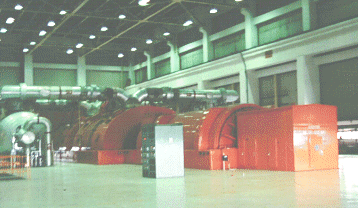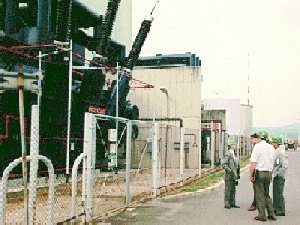
The Generator also has a voltage-regulator that maintains the voltage within acceptable limits.
Main Generator and Support Systems
Regardless of type of power plant - coal, nuclear, or whatever, they all have one or more generators.
The Generator has one major function:
- Generate AC electricity to supply the grid. The generator voltage is nominally 20-22 KV (1 KV=1000 volts). The frequency is either 50 or 60 cycles per second. This frequency is determined by the rotating speed of the generator - between 1500 and 3600 cycles per second.
The Generator Support Systems have the following functions:
- Cool the generator
- Lubricate the generator
- Keep the hydrogen gas inside the generator
- Keep the cables cool between the generator and the generator transformer
The Generator Transformer has one function:
- Increase the voltage from about 20 KV to either 220 KV or 345 KV.
Major Components
Generator
 |
The Generator consists of
an exciter, a stator and rotor. The exciter keeps a low
voltage going through the wires of the rotor. When this
rotor turns, it induces a voltage in the stator. The Generator also has a voltage-regulator that maintains the voltage within acceptable limits. |
| Photo by J.A. Gonyeau | |
Hydrogen Cooling
Hydrogen gas is used inside the generator for cooling. The hydrogen is, is turn, cooled by the Ultimate Cooling System.
Lubricating and Seal Oil Systems
An oil system is used for lubricating the bearings on the generator, much like the oil system in a car. Another oil system is used to keep the hydrogen in the generator. This oil is also cooled by the Ultimate Cooling System.
Bus Duct Cooling
The cables or large bars between the generator and the main transformer are contained within large pipes called the Bus Duct. Fans drive air across these cables / bars to remove the heat. The air is, in turn, cooled by the Ultimate Cooling System.
Generator Transformer
 |
Main Generator transformer used to raise voltage from ~ 20 KV to either 220 KV to 345 KV. Note size relative to a person. Fans are used to cool the oil used in the transformer. |
| Photo by J.A. Gonyeau | |
Copyright © 1996-2004. Joseph Gonyeau, P.E.. The Virtual Nuclear Tourist. All rights reserved. Revised: March 15, 2001.